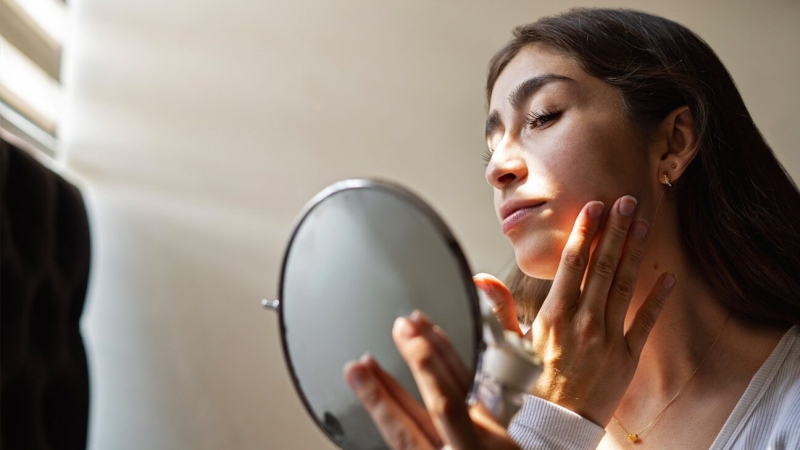
- The viral “blackout challenge” (also known as the “choking challenge) is responsible for at least one death this year.
- The challenge, which is being shared on various social media platforms, encourages viewers to asphyxiate themselves until they lose consciousness.
- Asphyxiation is incredibly dangerous and can lead to permanent brain damage and death in less than five minutes.
Following the death of her son, a mom is warning others about the “blackout challenge” (also known as the “choking challenge”), a dangerous viral trend that’s being shared on social media platforms like TikTok.
In an editorial for Huffpost, Joann Bogard describes the tragedy of losing her son Mason in 2019. Like other kids his age, he’d shown an interest in social media “challenges.” Challenge videos encourage social media users to copy an activity from social media and then perform it themselves, posting the video for all to see. Many can be relatively innocuous, but some are far more dangerous.
The “blackout challenge,” which encourages individuals to asphyxiate themselves to the point of losing consciousness, falls into the latter. It is extremely dangerous. Mason lost his life after attempting the challenge and accidentally choking himself to death. Now Bogard is helping other parents to become better educated about social media and online trends.
“What worries me most today is that what happened to Mason and our family can happen to anyone — and has happened to others. Families are desperately seeking answers on how to protect their children online,” she wrote for Huffpost.
What is the “blackout challenge?”
The “blackout challenge,” or “choking challenge,” is an online challenge proliferated through social media apps such as TikTok that encourages viewers to asphyxiate themselves until they lose consciousness. The loss of consciousness is believed to be associated with a “high” or feeling of euphoria. Challenge videos may be particularly appealing to teens and adolescents.
Unlike other dangerous trends that have come and gone over the years, such as the Tide pod challenge, variations of challenges related to asphyxiation tend to crop up every couple of years.
“This is a trend that seems to come of age with each progressive generation,” said Mary Beth Howard, MD, MSC, a Pediatric Emergency Medicine Physician at Johns Hopkins Children’s Center.
“It’s very dangerous to begin with, and the other issue at hand is that we have social media and these very powerful algorithms that are propagating these very dangerous behaviors,” she said.
Benjamin Morse, BA, a Visiting Lecturer in New Media and social media expert at the University of Nevada, Las Vegas, told Healthline, “These trends take off, and they accelerate at such a speed that something tragic can happen before a parent is even aware of what their kids are watching.”
The dangers of asphyxiation
Asphyxiation is extremely dangerous and can quickly lead to brain damage and death. There is also the added risk that an individual may take part in the “blackout challenge” by themself, without any form of supervision, greatly increasing the danger.
“When you deprive the brain of oxygen and you go unconscious, that’s it, you’re not able to stop the event,” said Marla Levine, MD, an Associate Professor of Clinical Pediatrics and Director of Emergency Medicine at Vanderbilt University Medical Center.
“You have a brief period of time where you can then reestablish blood supply or oxygen to your brain to prevent cerebral death,” she said.
Asphyxiation leads to a condition known as cerebral hypoxia, literally depriving the brain of oxygen.
The brain can be deprived of oxygen with as little as 4.4 pounds of pressure and can cause loss of consciousness in just ten seconds. When hypoxia begins, permanent brain damage can occur within just four minutes. Brain death can occur within five minutes of hypoxia.
“We’re not talking about a long period of time here,” said Levine.
There are also no hard rules for how asphyxiation may affect one individual to the next.
“Everyone’s response to these challenges is variable. So someone could pass out within seconds, someone may take closer to a minute,” said Howard. That variability makes the challenge even more dangerous since an individual may lose consciousness much faster than they anticipate.
Other dangers from asphyxiation include:
- Damaging the larynx, tissue, and blood vessels of the neck.
- Heart attack and cardiac arrest
- Aspiration (vomit in the airways)
If an individual is asphyxiating and has lost consciousness, immediately contact emergency services such as 911.
How to talk with adolescents about social media trends
Speaking to a child about social media and dangerous online challenges may not be easy, but prevention should be a top priority for all parents.
How parents, companies, and lawmakers monitor and regulate social media can be a thorny issue. While some advocate for greater responsibility and censorship from social media companies themselves, Morse recommends a more pragmatic approach.
“Waiting for the platforms to do the work is not going to happen,” he said.
Instead, he recommends parents actively engage with the platforms and apps that their children are using and set appropriate boundaries.
“If your kids are on TikTok, you need to be on TikTok. I know that’s not a fun answer for parents, but you need to understand what your kids are doing,” he told Healthline.
“It’s so incredibly important that parents are vigilant in having conversations with their children and vigilant about what they’re consuming in social media,” said Levine.
The bottom line
A dangerous social media trend known as the “choking challenge,” which encourages viewers to asphyxiate themselves until they lose consciousness, has resulted in at least one death.
Asphyxiation can result in brain damage and death in as little as four minutes.
Parents are encouraged to have open and informed conversations with their children about social media to help set safe boundaries.




